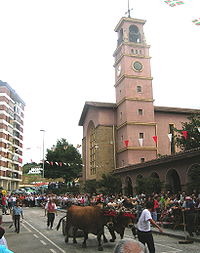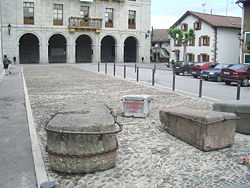
Idi probak
Encyclopedia

Spanish language
Spanish , also known as Castilian , is a Romance language in the Ibero-Romance group that evolved from several languages and dialects in central-northern Iberia around the 9th century and gradually spread with the expansion of the Kingdom of Castile into central and southern Iberia during the...
this sport is called arrastre de piedra (stone dragging) or prueba de bueyes (oxherd test) and concours de bœf (oxen competition) in French
French language
French is a Romance language spoken as a first language in France, the Romandy region in Switzerland, Wallonia and Brussels in Belgium, Monaco, the regions of Quebec and Acadia in Canada, and by various communities elsewhere. Second-language speakers of French are distributed throughout many parts...
.
Location
Although idi probak can in theory be carried out on any reasonably flat surface, the preference is to conduct them on specially constructed proba tokiak (test places). They are ideally:- 22.3m wide, with 8 lanes of 2.79m
- cobbled to reduce friction
- on totally flat ground
- between 22-28m long although this may vary depending on the space available
Some have a paved surface but these are unpopular because the oxen find it more difficult to get a good grip on a smooth surface.
Rules

Baserri
A baserri is a traditional type of half-timbered or stone-built farmhouse found in the Basque Country in Northern Spain and Southwestern France. The baserris, with their gently sloping roofs and entrace portals, are highly characteristic of the region and form a vital part in traditional Basque...
s (Basque farmhouses) still have their own rocks for dragging.
As all oxen in the Basque Country
Basque Country (historical territory)
The Basque Country is the name given to the home of the Basque people in the western Pyrenees that spans the border between France and Spain on the Atlantic coast....
, they are yoked at the horns.
The rocks, called probarriak or "test rocks", are roughly rectangular, slightly narrower at the front end with a hole for attaching the chain. The weight varies from town to town and may be between 1500-4000 kg or higher. For example, in Tolosa
Tolosa, Spain
Tolosa is a town and municipality to the south of Donostia-San Sebastián in the Basque province of Gipuzkoa, Spain. It is located in a valley of the river Oria and overlooked by Uzturre, a white cross-topped mountain.-Famous people from Tolosa:...
the stones weight 4000 kg, in Gernika 4500 kg. The town of Berriatua
Berriatua
Berriatua is a town and municipality located in the province of Biscay, in the autonomous community of the Basque Country, in the north of Spain. Neighbors are Ondarroa and the Bay of Biscay to the North, Markina-Xemein to the South, Mutriku to the East, Amoroto and Mendeja to the West....
has a rock in the proba toki weighing 5250 kg but hasn't been used since 1950 mainly because today the preference is to see the teams complete more circuits rather than drag larger rocks. If an oxen is over the weight limit (usually around 1100 kg), extra weights are put on the probarriak. For every kilo the ox is over, 1.5 kg are added to the rock.
The goal of the competition is to complete as many plaza (the distance between the two ends of the proba toki) as possible within a given space of time. Today this is normally half an hour but has been known to last up to two hours.
Straws
Drawing straws
Drawing straws is a selection method that is used by a group to choose one member of the group to perform a task after none has volunteered for it...
are drawn to decide the order in which the teams compete. To go first is not considered fortunate as there will be no reference as to the performance of the other teams yet.
The start is announced with a whistle. The itzaina (ox-herder) and the akuilutzaileak (goaders) now have to steer the oxen along the track. The itzaina leads the team from the front, the akuilutzaile tries to steer both the oxen and the rock from the back. Ideally a team completes a full plaza without stopping as it costs a lot of energy to get the rock moving. They also try to keep to the middle of the track because if a rock touches or goes over the side demarcation this is seen as a foul and the team has to restart from the place the rock went over the line. Once the other side is reached, the team has to turn around and return to the sart line.
At the end of the competition, the referees announce the results both in plazak and meters raced.
The number of prodders can vary depending on the bets or the rules for the event. Usually a team of two is used but there are also events where only one ox is used, which is called uztarri bakarrean or "single yoke".
Women and idi probak
Traditionally a male dominated sport, women have begun to take part in idi probak in recent years as they have in other Basque sports.History
As so many Basque sports, the idi proba has its roots in the rural communities. Oxen were in widespread use due to the hilly topographyTopography
Topography is the study of Earth's surface shape and features or those ofplanets, moons, and asteroids...
of the Basque Country to which oxen are better suited than horses or mules.
Traditionally the oxen were used as working oxen during the year and put onto light duty and receiving a special diet only in the run-up to the probak. Today few people keep working oxen and most are kept and trained solely for the probak.
Doping and animal welfare
The popularity of the sport and the associated heavy betting has not left the sport unscathed. The Basque oral tradition records cases of animal maltreatment with trainers spurning on their teams too harshly and such cases also occur today.There has also been a number of cases of doping
Doping (sport)
The use of performance-enhancing drugs in sport is commonly referred to by the term "doping", particularly by those organizations that regulate competitions. The use of performance enhancing drugs is mostly done to improve athletic performance. This is why many sports ban the use of performance...
. Although the number of cases is low, the Basque regional governments started introducing anti-doping measures in 1997 and created the office of Official Veterinarian in 2005 to help ensure good practice.

